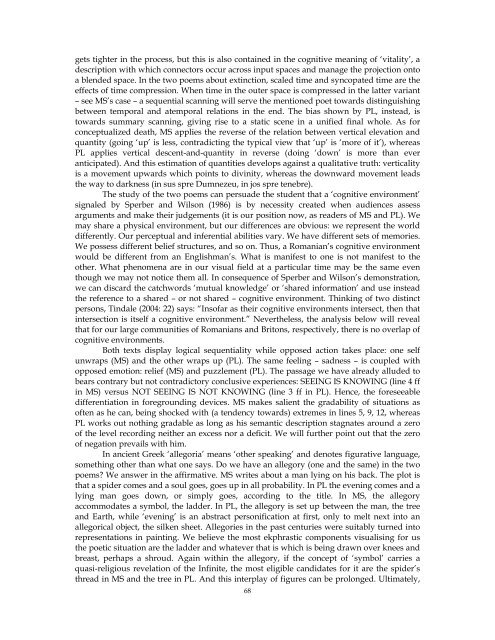You also want an ePaper? Increase the reach of your titles
YUMPU automatically turns print PDFs into web optimized ePapers that Google loves.
gets tighter in the process, but this is also contained in the cognitive meaning of ‘vitality’, a<br />
<strong>de</strong>scription with which connectors occur across input spaces and manage the projection onto<br />
a blen<strong>de</strong>d space. In the two poems about extinction, scaled time and syncopated time are the<br />
effects of time compression. When time in the outer space is compressed in the latter variant<br />
– see MS’s case – a sequential scanning will serve the mentioned poet towards distinguishing<br />
between temporal and atemporal relations in the end. The bias shown by PL, instead, is<br />
towards summary scanning, giving rise to a static scene in a unified final whole. As for<br />
conceptualized <strong>de</strong>ath, MS applies the reverse of the relation between vertical elevation and<br />
quantity (going ‘up’ is less, contradicting the typical view that ‘up’ is ‘more of it’), whereas<br />
PL applies vertical <strong>de</strong>scent-and-quantity in reverse (doing ‘down’ is more than ever<br />
anticipated). And this estimation of quantities <strong>de</strong>velops against a qualitative truth: verticality<br />
is a movement upwards which points to divinity, whereas the downward movement leads<br />
the way to darkness (in sus spre Dumnezeu, in jos spre tenebre).<br />
The study of the two poems can persua<strong>de</strong> the stu<strong>de</strong>nt that a ‘cognitive environment’<br />
signaled by Sperber and Wilson (1986) is by necessity created when audiences assess<br />
arguments and make their judgements (it is our position now, as rea<strong>de</strong>rs of MS and PL). We<br />
may share a physical environment, but our differences are obvious: we represent the world<br />
differently. Our perceptual and inferential abilities vary. We have different sets of memories.<br />
We possess different belief structures, and so on. Thus, a Romanian’s cognitive environment<br />
would be different from an Englishman’s. What is manifest to one is not manifest to the<br />
other. What phenomena are in our visual field at a particular time may be the same even<br />
though we may not notice them all. In consequence of Sperber and Wilson’s <strong>de</strong>monstration,<br />
we can discard the catchwords ‘mutual knowledge’ or ‘shared information’ and use instead<br />
the reference to a shared – or not shared – cognitive environment. Thinking of two distinct<br />
persons, Tindale (2004: 22) says: “Insofar as their cognitive environments intersect, then that<br />
intersection is itself a cognitive environment.” Nevertheless, the analysis below will reveal<br />
that for our large communities of Romanians and Britons, respectively, there is no overlap of<br />
cognitive environments.<br />
Both <strong>text</strong>s display logical sequentiality while opposed action takes place: one self<br />
unwraps (MS) and the other wraps up (PL). The same feeling – sadness – is coupled with<br />
opposed emotion: relief (MS) and puzzlement (PL). The passage we have already allu<strong>de</strong>d to<br />
bears contrary but not contradictory conclusive experiences: SEEING IS KNOWING (line 4 ff<br />
in MS) versus NOT SEEING IS NOT KNOWING (line 3 ff in PL). Hence, the foreseeable<br />
differentiation in foregrounding <strong>de</strong>vices. MS makes salient the gradability of situations as<br />
often as he can, being shocked with (a ten<strong>de</strong>ncy towards) extremes in lines 5, 9, 12, whereas<br />
PL works out nothing gradable as long as his semantic <strong>de</strong>scription stagnates around a zero<br />
of the level recording neither an excess nor a <strong>de</strong>ficit. We will further point out that the zero<br />
of negation prevails with him.<br />
In ancient Greek ‘allegoria’ means ‘other speaking’ and <strong>de</strong>notes figurative language,<br />
something other than what one says. Do we have an allegory (one and the same) in the two<br />
poems? We answer in the affirmative. MS writes about a man lying on his back. The plot is<br />
that a spi<strong>de</strong>r comes and a soul goes, goes up in all probability. In PL the evening comes and a<br />
lying man goes down, or simply goes, according to the title. In MS, the allegory<br />
accommodates a symbol, the lad<strong>de</strong>r. In PL, the allegory is set up between the man, the tree<br />
and Earth, while ‘evening’ is an abstract personification at first, only to melt next into an<br />
allegorical object, the silken sheet. Allegories in the past centuries were suitably turned into<br />
representations in painting. We believe the most ekphrastic components visualising for us<br />
the poetic situation are the lad<strong>de</strong>r and whatever that is which is being drawn over knees and<br />
breast, perhaps a shroud. Again within the allegory, if the concept of ‘symbol’ carries a<br />
quasi-religious revelation of the Infinite, the most eligible candidates for it are the spi<strong>de</strong>r’s<br />
thread in MS and the tree in PL. And this interplay of figures can be prolonged. Ultimately,<br />
68












